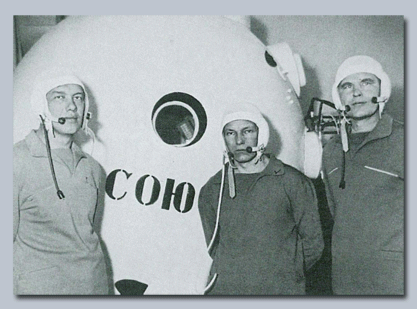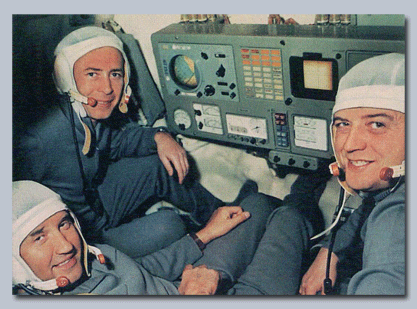| SALYUT Space Stations
After having sent a man into space and then landing on the moon, the next goal in the space race between the USA and the USSR was the design of space stations, or rather of outposts that could orbit a planet.
With the beginning of the space age, orbital stations were structures of medium to large dimensions that were destined to orbit the Earth for quite long periods of time and to house crews of astronauts, the numbers of which differed depending on the size of the station. These crews were involved in performing scientific experiments and programmes of different natures (observation of the Universe and the Earth, human physiology and biology, analysis of materials and the physics of liquids etc.)
The Soviet Union, following the disappointment of the first American moon landing and strengthened by the creation of the Soyuz capsule as a vehicle to transport astronauts into orbit, sent the first prototype of a space station, the Salyut-1, into orbit on 19 April 1971.
Just two years later the United States also achieved this goal upon launching the Skylab on 14 May 1973.
Salyut-1 was the very first space station, but the crew, made up of cosmonauts Shatalov, Yeliseev and Rukavishnikov, performed only one docking manoeuvre with the Soyuz-10 capsule without actually managing to transfer into the new space station: mechanical docking worked perfectly but the hermetic connection between the two space crafts failed.

April 1971. Cosmonauts Shatalov, Yeliseev and Rukavishnikov attempt the first docking with Salyut-1
|
The first official visit on board the station happened a very short time after the first attempt, when on 6 June 1971 on board the Soyuz-11 the three cosmonauts Dobrovolsky, Volkov and Patsayev successfully managed to perform docking with Salyut-1, and obtained the first record for remaining in orbit (24 days). But this success ended in tragedy: after landing, upon opening the capsule, the three cosmonauts, who were not wearing their spacesuits, were found dead, victims of depressurization during their return into the atmosphere due to an exhaust valve being left open.

June 1971. Cosmonauts Dobrovolsky, Patsayev and Volkov, the first "residents"
of the Salyut-1 space station for 24 days, tragically died upon re-entry
|
The Soviet programme, which had began in '71, suffered a real setback after this tragedy and only in April of 1973 was the new Salyut-2 space station launched, unsuccessfully however, due to technical problems.
The Soviet Union then continued with the Salyut-3 (June 1974 - January 1975), 4 (December 1974 - February 1977), 5 (June 1976 - August 1977), 6 (September 1977 - July 1982) and 7 (April 1982 - February 1991).
From Salyut-1 to Salyut-5 the model was practically identical: reduced dimensions (about 16 metres in length and with a diameter of around 4.15 metres), a port for docking Soyuz capsules, central living quarters where the solar panels were also located, and an end where the engines and other instrumentation were situated.
With the Salyut-6 the second generation of Soviet space stations began, with the possibility of refuelling and 2 docking ports, one forward and one aft, which allowed temporary docking of Soyuz spacecrafts and/or Cargo Progress (automatic refuelling craft) and therefore the sending of relief crews without having to leave the station unmanned. It was in January of 1978 that the first docking with three vehicles in the cosmos took place (Soyuz-27 - Salyut-7 - Soyuz-26).
|
